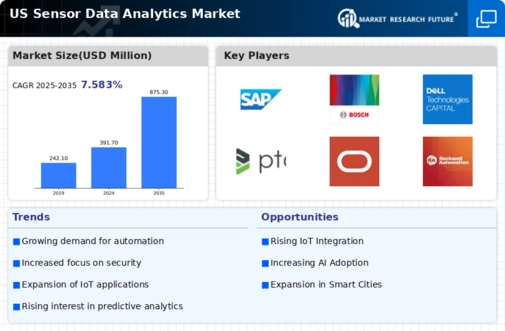Advancements in Sensor Technology
Advancements in sensor technology are significantly influencing the sensor data-analytics market. Innovations such as miniaturization, enhanced accuracy, and improved connectivity are enabling the deployment of sophisticated sensors across various applications. For example, the integration of advanced sensors in smart cities is projected to reach a market value of $1 trillion by 2025, highlighting the potential for data-driven urban management. These technological advancements not only enhance data collection capabilities but also facilitate more comprehensive analytics, allowing organizations to derive actionable insights. As sensor technology continues to evolve, the sensor data-analytics market is poised for substantial growth, driven by the increasing complexity and volume of data generated.
Rising Demand for Real-Time Data Processing
The sensor data-analytics market is experiencing a notable surge in demand for real-time data processing capabilities. Industries such as manufacturing, healthcare, and transportation are increasingly relying on instantaneous data insights to enhance operational efficiency and decision-making. For instance, the manufacturing sector is projected to invest approximately $5 billion in sensor technologies by 2026, driven by the need for real-time monitoring and analytics. This trend indicates a shift towards more agile and responsive business models, where timely data can lead to improved productivity and reduced downtime. As organizations recognize the value of immediate insights, the sensor data-analytics market is likely to expand, fostering innovation and competitive advantage across various sectors.
Expansion of Smart Infrastructure Initiatives
The expansion of smart infrastructure initiatives is a key driver for the sensor data-analytics market. Governments and private entities are investing heavily in smart city projects, which leverage sensor data to optimize urban services and improve quality of life. For instance, the U.S. Department of Transportation has allocated over $100 million for smart transportation initiatives, emphasizing the role of sensor data in traffic management and public safety. This trend suggests a growing recognition of the value of data analytics in enhancing infrastructure efficiency. As smart infrastructure projects proliferate, the demand for sensor data-analytics solutions is likely to increase, fostering collaboration between technology providers and urban planners.
Growing Emphasis on Data Security and Privacy
In the context of the sensor data-analytics market, the growing emphasis on data security and privacy is becoming increasingly critical. With the proliferation of connected devices, concerns regarding data breaches and unauthorized access have escalated. Regulatory frameworks, such as the California Consumer Privacy Act (CCPA), are prompting organizations to prioritize data protection measures. This shift is likely to drive investments in secure data analytics solutions, as companies seek to comply with regulations while maintaining consumer trust. The market for data security solutions within the sensor data-analytics sector is expected to grow by 15% annually, reflecting the urgent need for robust security protocols that safeguard sensitive information.
Increased Focus on Sustainability and Energy Efficiency
The sensor data-analytics market is witnessing an increased focus on sustainability and energy efficiency. Organizations are increasingly utilizing sensor data to monitor and optimize energy consumption, thereby reducing their carbon footprint. For example, the energy sector is projected to invest over $20 billion in smart grid technologies by 2027, driven by the need for more efficient energy management. This trend indicates a broader commitment to environmental sustainability, as companies seek to leverage data analytics to achieve their sustainability goals. As the demand for energy-efficient solutions grows, the sensor data-analytics market is likely to benefit from heightened investments in technologies that promote sustainable practices.

















Leave a Comment